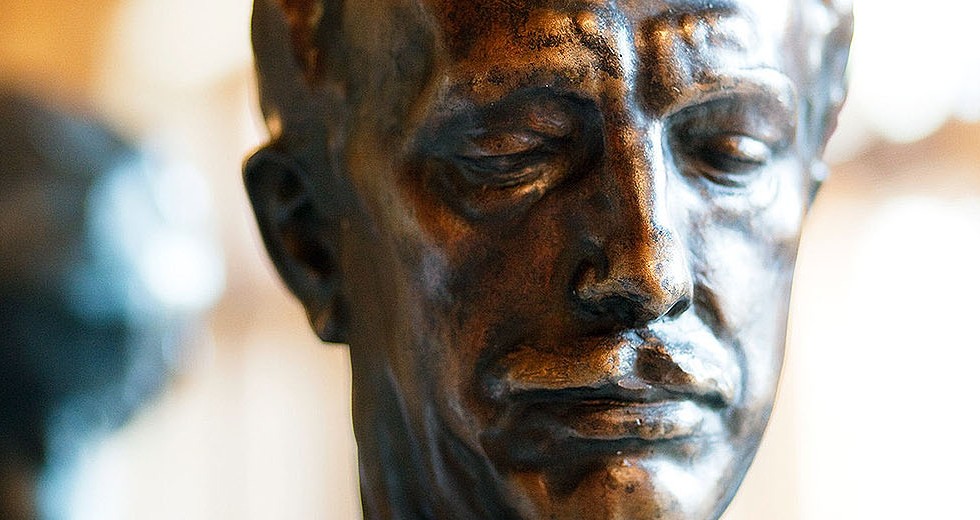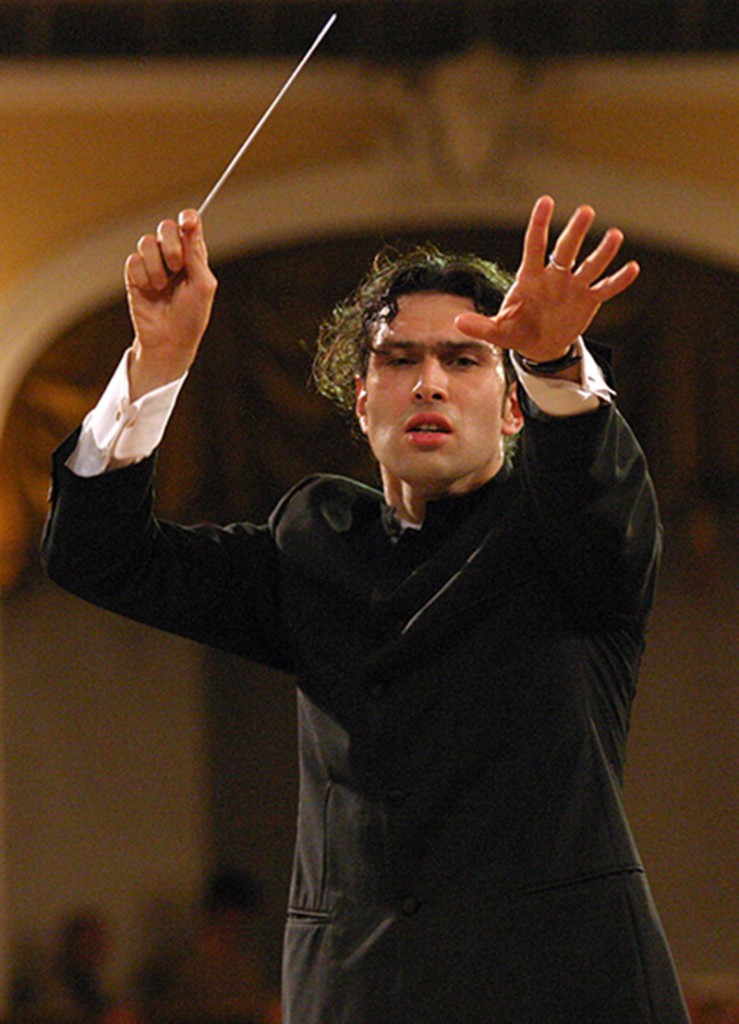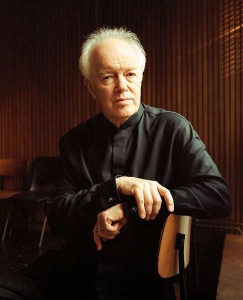
During the darkest days of winter’s end in 1945, the Austrian conductor Karl Böhm rushed into the burning edifice of the grand Vienna State Opera House. Allied bombers had ravaged the majestic structure, and Böhm, who held the top post at the venerable institution, hoped to salvage any of its remains.
“Absurdly, I tried to drag valuable pieces of furniture out of the still burning building,” he said of that day on March 12. “We placed them opposite the Opera, [and] the next day, of course, they were stolen.” The stage and auditorium were completely destroyed, as well as 150,000 costumes that had adorned some 120 operatic productions.
The next morning, a grief-stricken Richard Strauss set to orchestrating Metamorphosen. Over the previous year, this work-in-progress lingered under the name “Adagio”; meanwhile, Joseph Goebbels had closed all theaters and opera houses in the Reich. Completed on April 12, just weeks before Hitler’s suicide, this elegiac opus for 23 solo strings has become synonymous with the destruction of German culture. A month before Vienna, the Dresden Opera House — where so many of Strauss’ works had premiered — was carpet-bombed into oblivion, along with the Lindenoper in Berlin. In his diary, Strauss famously wrote that “2000 years of cultural evolution had met its doom, and irreplaceable monuments of architecture and works of art were destroyed by a criminal soldiery.”
Writing in LA Weekly years later, the critic Alan Rich succinctly captured the essence of Metamorphosen: “Solemn, dark, and resigned music from the end of a sorrowing composer’s life.”
 The Chicago Symphony Orchestra will perform Metamorphosen in an all-Strauss program May 15-17, along with an Afterworks Masterworks concert May 16. On the podium, Edo de Waart (below, left) will replace the originally scheduled Vladimir Jurowski (at right), who had to cancel his CSO engagement due to illness. (He spoke in April for this article.) In the fall, he will return to Symphony Center on Oct. 18 with the London Philharmonic, where he has been principal conductor since 2007, to conduct Shostakovich’s Eighth.
The Chicago Symphony Orchestra will perform Metamorphosen in an all-Strauss program May 15-17, along with an Afterworks Masterworks concert May 16. On the podium, Edo de Waart (below, left) will replace the originally scheduled Vladimir Jurowski (at right), who had to cancel his CSO engagement due to illness. (He spoke in April for this article.) In the fall, he will return to Symphony Center on Oct. 18 with the London Philharmonic, where he has been principal conductor since 2007, to conduct Shostakovich’s Eighth.
In our phone interview, Jurowski was refreshingly candid in his opinions on Strauss and his music. “We know the inspiration for Metamorphosen came when he saw those pictures of the destroyed opera houses,” he said from his home in Germany. “And these were the opera houses in his life, so he felt his lifework was finished with them. It was not so much about the ruins in which the entire country was under, but specifically the destruction of the cultural heritage, which devastated Strauss, telling you something about the way this man was thinking: Art was everything for him, and the daily lives of other people meant nothing to him.”
Music historian Michael H. Kater notes that Strauss’ biographers either viewed him as “fascist or apolitical.” Strauss was initially supportive of a Hitler dictatorship if it meant greater state-sponsored support for his music and field. Yet Strauss’ affection for the Fuhrer and his cronies would eventually sour. He feared for his family’s life, especially that of his Jewish daughter-in-law and Jewish grandchildren. In 1944, the Gestapo abducted and imprisoned his daughter-in-law, Alice, and her son for several days. Strauss thought little of the Third Reich’s henchmen, calling their tactics “untalented” and “mediocre.” The feeling was mutual: Goebbels had long distrusted and disliked Strauss, and Hitler had once felt Strauss’ late Romantic music to be “completely second rate.”
If Strauss was not much of a political person — “like a child,” as Goebbels called him — then his partisan allegiance was to the Austro-German art, literature and music that surrounded him. It is this political “aloofness,” as Jurowski describes it, that allowed him to become such a prolific composer and cultural sponge. Metamorphosen is in many ways a subtle tribute to the German artistry he worshipped. Toward the end of the work, Strauss quotes several bars of Beethoven’s funeral march from the Eroica Symphony, and Strauss initially drew inspiration from Goethe’s poem “No one can know himself,” which he had originally planned to set to choral music.
For Jurowski, the music contains elements of every opera he ever wrote. “His entire life can be seen through the prism of his vocal works,” the Moscow-born maestro said. “You can see the traces of Metamorphosen in many of his earlier works. Die Frau Ohne Schatten, Ariadne auf Naxos and Capriccio — they all could have been taken out of Metamorphosen.” He believes the piece is a review of Strauss’ artistic life, as if the composer were looking at his opera oeuvre and seeing all his children and ex-lovers.
Jurowski, who made his American debut at the Met in 1999, also sees many technical similarities between Strauss and Wagner operas. For him, the art of mixing and developing leitmotifs is completely uninterrupted: a natural wellspring of compositional thought. “You are not aware of it being a complicated construct,” he said, “but the final result is an absolutely organic flow. If you analyze Metamorphosen, you could deconstruct it down to four or five main motifs, which are being shuffled around, but Strauss does so with such ease and fluidity, you are never aware of it.”
 The work also has served as laboratory material for performers and conductors looking to maximize the music’s effect. It has been performed anywhere from a septet chamber piece to ensemble forces 10 times that. Herbert von Karajan once conducted it with 23 players before having the full orchestra join in. The Chamber Orchestra of Europe once performed it in the traditional setting, but without a conductor. Yannick Nezet Seguin recently had all 23 soloists stand for the duration of the performance.
The work also has served as laboratory material for performers and conductors looking to maximize the music’s effect. It has been performed anywhere from a septet chamber piece to ensemble forces 10 times that. Herbert von Karajan once conducted it with 23 players before having the full orchestra join in. The Chamber Orchestra of Europe once performed it in the traditional setting, but without a conductor. Yannick Nezet Seguin recently had all 23 soloists stand for the duration of the performance.
“Strauss was seriously attracted to numbers and proportions in music,” Jurowski said. “The number 23 has no real numerological significance, except that it’s the best possible proportion, which makes the best possible sound,” he said, adding that a thicker texture of sound adds weight but not clarity. “Twenty-three top-class players give you more emotion than 60 or 70.”
As the British writer Simon Thompson has remarked: “It’s 23 or bust.”
This year marks the 150th anniversary of Strauss’ birth, so the CSO’s all-Strauss program, in addition to Metamorphosen, will feature the Serenade in E-Flat, the Oboe Concerto (with CSO Principal Eugene Izotov as soloist), and the ravishing Four Last Songs.
Jurowski programmed the concert to showcase Strauss’ development as a composer, but admits that he would never design a full program of his music in a non-anniversary season. “Richard Strauss is an interesting but problematic composer, and there are certain works I’ve championed, such as Metamorphosen, Four Last Songs and Zarathustra, but there are some I would not,” he said. “Don Juan? Ein Heldenleben? I don’t understand this music. Let me say I understand its value for the development of orchestral sonority, but as a piece of music, I can’t cope with it. There are many works of his I can easily live without.”
Metamorphosen, however, isn’t one of them. It is, as Strauss biographer Matthew Boyden points out, “what many consider to be his greatest work.”
Bryant Manning is a Texas-based instructor and freelance writer.
TOP PHOTO: A detail of a bust of Richard Strauss in the lobby of the Wiener Staatsoper.
BELOW: Audio notes for this all-Strauss program.